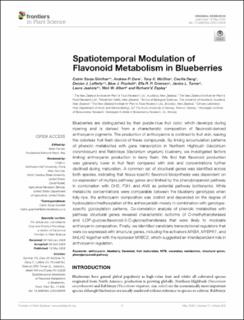| dc.contributor.author | Günther, Catrin Sonja | |
| dc.contributor.author | Dare, Andrew P. | |
| dc.contributor.author | McGhie, Tony K. | |
| dc.contributor.author | Deng, Cecilia | |
| dc.contributor.author | Lafferty, Declan J. | |
| dc.contributor.author | Plunkett, Blue J. | |
| dc.contributor.author | Grierson, Ella R.P. | |
| dc.contributor.author | Turner, Janice L. | |
| dc.contributor.author | Jaakola, Laura | |
| dc.contributor.author | Albert, Nick W. | |
| dc.contributor.author | Espley, Richard V. | |
| dc.date.accessioned | 2021-02-09T09:47:42Z | |
| dc.date.available | 2021-02-09T09:47:42Z | |
| dc.date.created | 2020-10-05T11:15:31Z | |
| dc.date.issued | 2020-05-13 | |
| dc.identifier.citation | Frontiers in Plant Science. 2020, 11 . | en_US |
| dc.identifier.issn | 1664-462X | |
| dc.identifier.uri | https://hdl.handle.net/11250/2726812 | |
| dc.description.abstract | Blueberries are distinguished by their purple-blue fruit color, which develops during ripening and is derived from a characteristic composition of flavonoid-derived anthocyanin pigments. The production of anthocyanins is confined to fruit skin, leaving the colorless fruit flesh devoid of these compounds. By linking accumulation patterns of phenolic metabolites with gene transcription in Northern Highbush (Vaccinium corymbosum) and Rabbiteye (Vaccinium virgatum) blueberry, we investigated factors limiting anthocyanin production in berry flesh. We find that flavonoid production was generally lower in fruit flesh compared with skin and concentrations further declined during maturation. A common set of structural genes was identified across both species, indicating that tissue-specific flavonoid biosynthesis was dependent on co-expression of multiple pathway genes and limited by the phenylpropanoid pathway in combination with CHS, F3H, and ANS as potential pathway bottlenecks. While metabolite concentrations were comparable between the blueberry genotypes when fully ripe, the anthocyanin composition was distinct and depended on the degree of hydroxylation/methoxylation of the anthocyanidin moiety in combination with genotype-specific glycosylation patterns. Co-correlation analysis of phenolic metabolites with pathway structural genes revealed characteristic isoforms of O-methyltransferases and UDP-glucose:flavonoid-3-O-glycosyltransferase that were likely to modulate anthocyanin composition. Finally, we identified candidate transcriptional regulators that were co-expressed with structural genes, including the activators MYBA, MYBPA1, and bHLH2 together with the repressor MYBC2, which suggested an interdependent role in anthocyanin regulation. | en_US |
| dc.language.iso | eng | en_US |
| dc.publisher | Frontiers Media S.A. | en_US |
| dc.rights | Navngivelse 4.0 Internasjonal | * |
| dc.rights.uri | http://creativecommons.org/licenses/by/4.0/deed.no | * |
| dc.title | Spatiotemporal modulation of flavonoid metabolism in blueberries | en_US |
| dc.type | Peer reviewed | en_US |
| dc.type | Journal article | en_US |
| dc.description.version | publishedVersion | en_US |
| dc.rights.holder | © 2020 Günther, Dare, McGhie, Deng, Lafferty, Plunkett, Grierson, Turner, Jaakola, Albert and Espley | en_US |
| dc.source.pagenumber | 17 | en_US |
| dc.source.volume | 11 | en_US |
| dc.source.journal | Frontiers in Plant Science | en_US |
| dc.identifier.doi | 10.3389/fpls.2020.00545 | |
| dc.identifier.cristin | 1837013 | |
| dc.source.articlenumber | 545 | en_US |
| cristin.ispublished | true | |
| cristin.fulltext | original | |
| cristin.qualitycode | 2 | |

